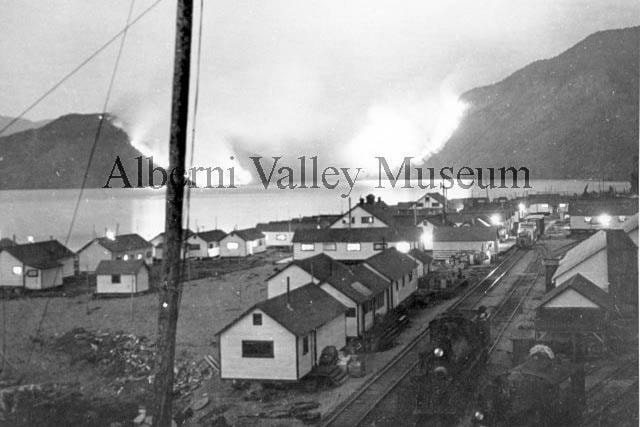When two logging companies joined forces on Jan. 17, 1925 and purchased 11,000 acres of prime timberland from the Esquimalt and Nanaimo (E&N) Railway, Great Central Lake’s reputation as a sawmill town was sealed.
The two companies were Bloedel, Stewart and Welch, and King-Farris Lumber Company. They amalgamated into the Great Central Sawmills Limited and proceeded to build a sawmill and accompanying milltown by the lake west of Port Alberni.
The sawmill was built in less than a year and the first shipment of lumber to leave the new mill happened a year after the partnership was formed, according to a Jan. 27, 1926 clipping from the Port Alberni News.
The mill was built as the timber was cut, and a railway was extended to the area for easier extraction and shipping of timber.
Permanent homes were built around the mill and townsite, however there were various camps—such as Camp Nine, depicted in the accompanying historical photo—where loggers lived and worked.
A more in-depth story of the Great Central Lake sawmill and surrounding community can be found in When the Whistle Blew: The Great Central Story 1925–1952. The book was compiled in 2002 by a committee including Joan (Maultsaid) McBride, Roy McBride, Arthur, Les and Cora Skipsey and Jean (Boyes) Robinson, with editors Margery and Robert Vaughan and publisher Tom Paterson.
Forest fires happened annually, including one in 1944, according to When the Whistle Blew, that blanketed the milltown in ash “for days.” There is a photo in the book taken at night that shows the same perspective of Camp Nine with the fire depicted in the AV Museum’s historical photo, burning across the lake.
(The museum’s photo is labelled as May 1943, but the book states the fire was from 1944.)
Falling ash was also a problem in the fall when slash was burned.
The Alberni Valley Museum has a collection of historical books for sale all about the Alberni Valley. Call them at 250-720-2863 or visit them during visiting hours at 4255 Wallace St., beside the Port Alberni branch of the Vancouver Island Regional Library.
The museum has 24,000 historical photographs available online at https://portalberni.pastperfectonline.com.
For more news from Vancouver Island and beyond delivered daily into your inbox, please click here.
RELATED: Vancouver Island history unveiled in Broken Islands dig
RELATED: Four generations of Vancouver Island logging and mining stories in one show
susie.quinn@albernivalleynews.com
Like us on Facebook and follow us on Twitter
Want to support local journalism during the pandemic? Make a donation here.
